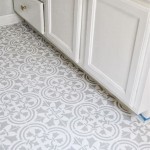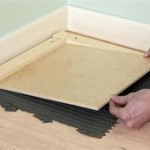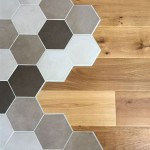Can You Tile Over Concrete Floor? A Comprehensive Guide
The question of whether one can tile over a concrete floor is a common one, particularly for homeowners and contractors undertaking renovation or new construction projects. The short answer is typically yes; however, the success of such an endeavor hinges on several critical factors concerning the preparation of the concrete substrate and the selection of appropriate materials and techniques. A poorly executed tiling project over concrete can lead to a variety of problems, including cracking, loosening, and the eventual need for costly repairs or complete replacement.
Concrete, as a flooring base, offers several advantages. It is inherently strong, durable, and, when properly prepared, provides a solid foundation for tile installation. Its thermal mass also contributes to energy efficiency, particularly when combined with radiant heating systems. However, concrete is also porous and susceptible to moisture absorption, potentially leading to issues if not addressed prior to tiling. This article will delve into the essential considerations for successfully tiling over concrete, covering aspects from surface preparation to adhesive selection and installation best practices.
Key Point 1: Assessing and Preparing the Concrete Substrate
Before initiating any tiling project over concrete, a thorough assessment of the existing surface is paramount. This evaluation should encompass several key areas, addressing both structural integrity and surface conditions that can impact tile adhesion. The following steps outline the necessary procedures:
1. Visual Inspection for Cracks and Damage: Begin with a comprehensive visual inspection of the concrete floor. Identify any cracks, both large and hairline, as well as any areas exhibiting spalling, crumbling, or other signs of damage. Cracks can be indicative of structural issues or ongoing movement within the concrete slab and should be addressed before tiling. Small hairline cracks may be bridgeable with crack isolation membranes, but larger cracks require professional evaluation and repair to prevent them from propagating through the tile layer. Spalling indicates deterioration of the concrete and necessitates repair to create a stable base.
2. Levelness Evaluation: Check the levelness of the concrete floor using a long level or, preferably, a laser level. Significant deviations from level can lead to uneven tile surfaces and require correction before tiling. High spots can be ground down, while low spots can be filled with self-leveling compound. Addressing unevenness not only ensures a professional-looking finished product but also prevents stress on the tiles that could lead to cracking or detachment.
3. Moisture Testing: Concrete is porous and can absorb moisture from the ground or surrounding environment. Excessive moisture can interfere with the adhesion of tile adhesives and lead to premature failure. Perform a moisture test using a calcium chloride test kit or a relative humidity probe to determine the moisture vapor emission rate (MVER) of the concrete slab. The results of this test will dictate the type of adhesive and any necessary moisture mitigation measures required. If the MVER exceeds the adhesive manufacturer's recommendations, a moisture barrier membrane may be necessary to prevent moisture from migrating through the concrete and affecting the tile installation.
4. Surface Cleaning and Preparation: Thoroughly clean the concrete surface to remove any dirt, dust, grease, oil, paint, or other contaminants that could impede adhesive bonding. Use a degreaser and scrub brush to address oil or grease stains. Etch the concrete surface with an acid-etching solution or mechanically abrade it to create a profile that enhances the bond between the concrete and the tile adhesive. Rinse the surface thoroughly after etching and allow it to dry completely before proceeding.
5. Filling Cracks and Imperfections: After cleaning, fill any cracks or imperfections in the concrete surface with a concrete patching compound. Allow the patching compound to dry and cure according to the manufacturer's instructions. Sand the patched areas smooth to ensure a consistent surface for tile installation. The type of patching compound should be compatible with the concrete and the tile adhesive being used.
Key Point 2: Selecting the Right Tile and Adhesive
Choosing the appropriate tile and adhesive is crucial for a successful and long-lasting tile installation over concrete. The specific requirements will depend on factors such as the type of tile being used, the expected traffic load, and the environmental conditions. Consider the following guidelines:
1. Tile Selection: Consider the intended use of the space and the prevailing environmental conditions when selecting tile. For high-traffic areas, choose durable tiles with a high PEI (Porcelain Enamel Institute) rating. For wet areas, select tiles with a low water absorption rate to prevent moisture damage. The size and type of tile will also impact the choice of adhesive and installation techniques. Larger tiles, for example, require a thicker mortar bed and may necessitate back buttering to ensure proper adhesion.
2. Adhesive Selection: The selection of an appropriate adhesive, often referred to as thin-set mortar, is critical for ensuring a strong and durable bond between the tile and the concrete substrate. Choose a high-quality thin-set mortar specifically designed for use with the type of tile being installed and the concrete substrate. Consider factors such as the tile size, weight, and porosity, as well as the presence of radiant heating systems or potential exposure to moisture. Polymer-modified thin-set mortars offer superior adhesion and flexibility compared to unmodified mortars and are generally recommended for tiling over concrete. Consult the adhesive manufacturer's specifications for proper mixing ratios, application techniques, and curing times.
3. Grout Selection: The choice of grout is also important for the overall durability and aesthetics of the tile installation. Select a grout that is appropriate for the tile type and the width of the grout joints. Epoxy grouts offer superior stain resistance and durability compared to cement-based grouts and are often recommended for high-traffic or wet areas. Consider the color of the grout as well, as it can significantly impact the overall appearance of the tiled surface. Seal the grout after installation to protect it from stains and moisture damage.
4. Crack Isolation Membranes: In cases where the concrete floor exhibits existing cracks or is prone to movement, a crack isolation membrane may be necessary to prevent cracking in the tile layer. These membranes are designed to absorb movement and stress within the concrete slab, preventing it from transferring to the tile surface. Apply the crack isolation membrane according to the manufacturer's instructions before installing the tile.
Key Point 3: Proper Installation Techniques and Best Practices
Even with proper surface preparation and material selection, the success of a tiling project over concrete ultimately depends on the adherence to sound installation techniques. Proper installation ensures a uniform, durable, and aesthetically pleasing finished product. The following steps outline best practices for tile installation:
1. Dry Layout: Before applying any adhesive, perform a dry layout of the tiles to determine the optimal tile placement and ensure a balanced and aesthetically pleasing pattern. This step allows for adjustments and modifications to the layout before the tiles are permanently installed. Consider the placement of expansion joints to accommodate movement within the concrete slab.
2. Mixing and Application of Thin-Set Mortar: Mix the thin-set mortar according to the manufacturer's instructions, using the correct water-to-powder ratio. Use a notched trowel of the appropriate size to apply the thin-set mortar to the concrete substrate, creating ridges that will provide a mechanical bond with the tile. Apply the thin-set mortar evenly, working in small sections to prevent it from drying out before the tiles are installed. Consider back-buttering larger tiles to ensure complete coverage of the tile surface.
3. Tile Placement and Alignment: Carefully place each tile onto the thin-set mortar bed, pressing it firmly into place and ensuring proper alignment with adjacent tiles. Use tile spacers to maintain uniform grout joints. Periodically check the levelness of the installed tiles using a level or straightedge. Remove any excess thin-set mortar from the grout joints as you go.
4. Curing and Grouting: Allow the thin-set mortar to cure for the recommended time period before grouting the tiles. This curing period allows the adhesive to fully harden and bond with the concrete and the tiles. After the thin-set mortar has cured, remove the tile spacers and apply the grout according to the manufacturer's instructions. Use a grout float to pack the grout firmly into the grout joints, removing any excess grout from the tile surface. Clean the tile surface with a damp sponge to remove any grout haze.
5. Sealing and Maintenance: After the grout has cured, seal it with a grout sealer to protect it from stains and moisture damage. Apply the sealer according to the manufacturer's instructions. Regularly clean the tiled surface with a neutral pH cleaner to maintain its appearance and prevent the buildup of dirt and grime. Avoid using harsh chemicals or abrasive cleaners that could damage the tile or grout.
Tiling over concrete floors is a viable and often desirable flooring solution. However, the success of such a project is heavily dependent on meticulous preparation, informed material selection, and adherence to best practice installation techniques. By addressing these critical areas, homeowners and contractors can achieve a durable, aesthetically pleasing, and long-lasting tiled floor over a concrete substrate.

Tiling Over A Ed Concrete Slab Fine Homebuilding
How To Tile Onto Concrete Floors Porcelain Super
:max_bytes(150000):strip_icc()/can-you-install-tile-directly-on-concrete-1822600-04-458f7bb6c78348c1835cf8054ef36553.jpg?strip=all)
How To Install Tile Over Concrete
How To Lay Floor Tiles On Concrete Stonesuper

How To Lay A Tile Floor On Concrete Diy Homeimprovement

Tile Over Concrete Subfloor An Easy Diy Tutorial

Sound Dampening Ceramic Tile Over A Concrete Floor Fine Homebuilding
Porcelain Tile Installation Over A Concrete Floor Like Pro Matrixgc

How To Lay Tile On Concrete With Pictures Wikihow

How To Install Tile Over Concrete The Right Way Part 1 Handyman
Related Posts








